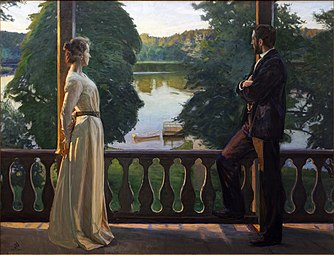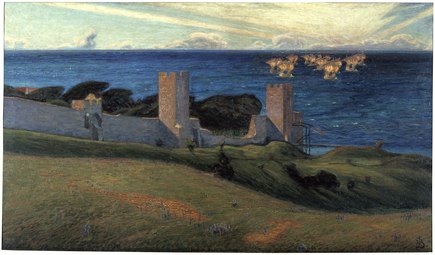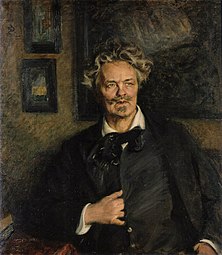Richard Bergh
This article includes a list of general references, but it lacks sufficient corresponding inline citations. (February 2019) |
Richard Bergh | |
|---|---|
landscape painter | |
| Signature | |
 |

Sven Richard Bergh (28 December 1858 – 29 January 1919) was a Swedish painter, art critic and museum manager. Despite many years in France, he remained unattracted to
Biography
Both of his parents,
The following year, he and his friend, Ernst Josephson, became members of the Nordic art colony at Grez-sur-Loing. That same year, he joined with the Swedish artists who became known as the opponents (Opponenterna); a group that was protesting what they felt were the outmoded teaching methods at the Academy. Shortly after, they created the Artists' Association (Konstnärsförbundet) and Bergh became its secretary. In 1886, he married Helena Maria Klemming (1863–1889), the daughter of a bookseller. Their daughter, Amie, was born the same year. He had painted her portrait in 1885, and she would serve as his model on many occasions over the course of their short marriage.[4]
Never in good health, Helena declined after Amie's birth and he became interested in attending séances. When she felt death approaching, they returned to Stockholm, at her request, and she died there from what is simply described as an "incurable disease". Not long after, he caught pneumonia and came close to death himself. During a long convalescence, one of those who cared for him was Gerda Winkrans (1864–1919), whose father was a local rector. He married her in 1890.
In 1893, Bergh and his family moved to
In 1904, he decided to settle in Storängen, Nacka Municipality (now part of Stockholm). He engaged the architect Albin Brag to design his home, now known as the Villa Bergh at Värmdövägen. He and Gerda would live there until their deaths. Despite this apparent retirement, in 1915 he accepted an appointment as curator (Överintendent) and director of the Nationalmuseum; spending his last years on a modernization project that featured new purchasing guidelines. During those years, he also wrote numerous essays on art and an account of his participation with the Opponenterna.[6]
His works may be seen at the
Richard Berghs väg, a street in Södra Ängby, Stockholm, was named after him.
Selected paintings
-
Hypnotic Seance (1887)
-
Nordic Summer Evening (1899–1900).
-
Vision: Scene from Visby (1894)
-
The Knight and the Maiden (1897) Thiel Gallery
-
August Strindberg (1905)
-
Gustaf Fröding (1909)
References
- ^ Karl Wåhlin. "S Richard Bergh". Svenskt biografiskt lexikon. Retrieved April 1, 2019.
- ^ Georg Nordensvan. "Johan Edward Bergh". Svenskt biografiskt lexikon. Retrieved April 1, 2019.
- ^ "Amanda Josefina Amalia Helena Bergh Helander". Lexikonett amanda. Retrieved April 1, 2019.
- ^ "Richard Bergh (Swedish painter, 1858–1919)". Masterpieces of Art. Retrieved April 1, 2019.
- ^ "HEDVIG Eleonora HAMILTON: Lexikonett amanda". www.lexikonettamanda.se. Retrieved 2020-01-25.
- ^ "Brag, Albin (1878–1937)". KulturNav. Retrieved April 1, 2019.
- ^ Göteborgs konstmuseum
- ^ Nationalmuseum
- ^ Nordiska museet
- ^ Uppsala universitetsbibliotek
- ^ Livrustkammarent
- ^ Prins Eugens Waldemarsudde
Further reading
- Thorbjörn Lengborn; Ellen Key – Gerda och Richard Bergh, "Ellen Key-sällskapet" series, 1997, Ellen Key-sällsk, Linköping
- Marie Näslund; "Konst är lif": Richard Berghs porträttmåleri under 1880-talet, 2002, Stockholms universitet, Konstvetenskapliga inst.
- Bengt-Arne Person; Varbergsskolan: Richard Bergh, Nils Kreuger, Karl Nordström, "Böcker om konst" series, 1993, Signum. ISBN 91-87896-15-X
- Birgitta Rapp; Richard Bergh – konstnär och kulturpolitiker 1890–1915, 1978, Rabén & Sjogren. ISBN 91-29-52741-4
External links
- More works by Bergh @ ArtNet
- Biography @ the Svenskt Biografiskt Lexikon
- Biography from the Svenskt Biografiskt Handlexikon @ Project Runeberg
- Biography from the Nordisk Familjebok@ Project Runeberg
- Hvad vår kamp gällt. Stämningsbilder från "opponenternas" 20-åriga verksamhet (What our struggle was about. "Mood images" from the "opponents" 20-years of activity) Full text @ Project Runeberg







